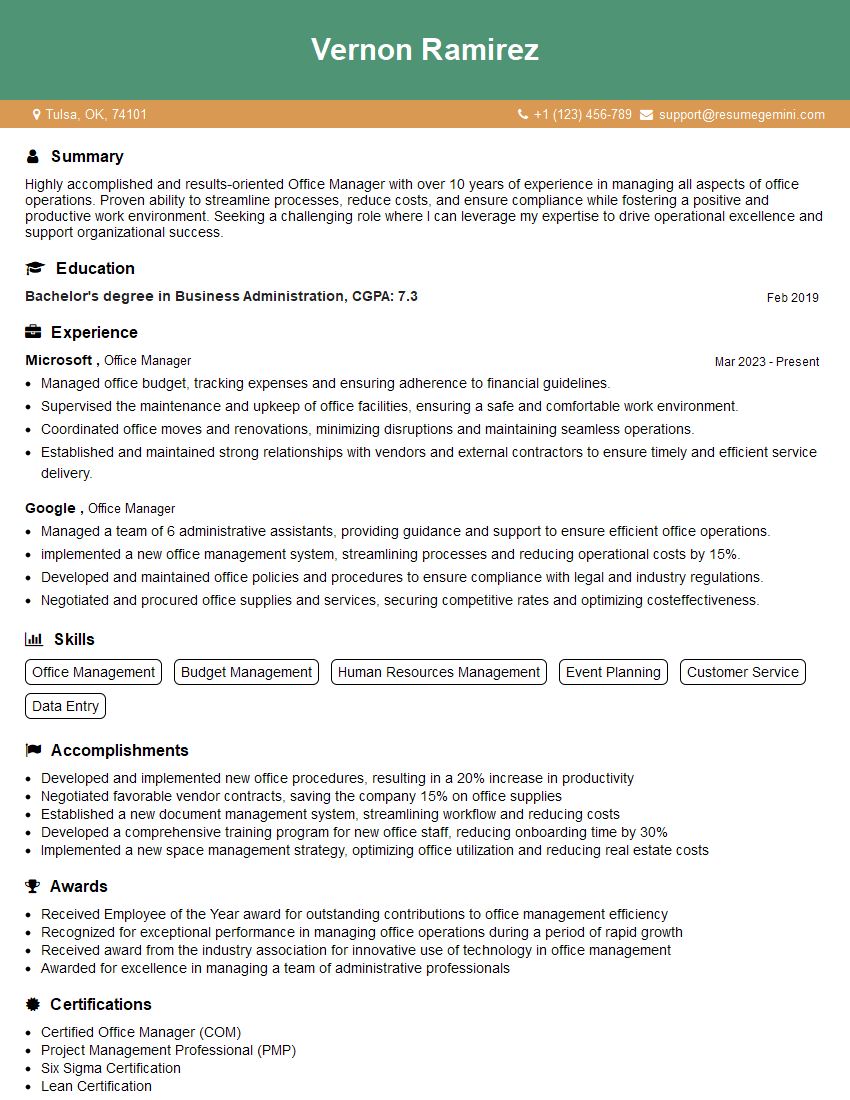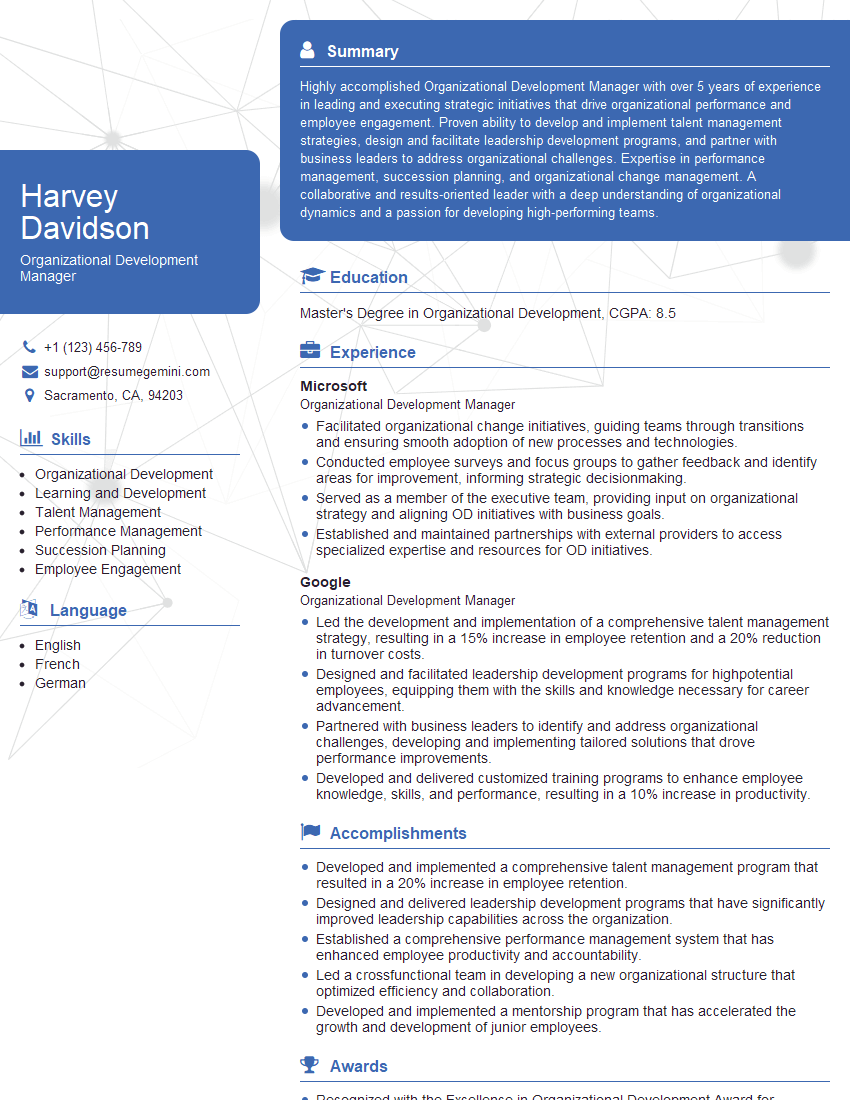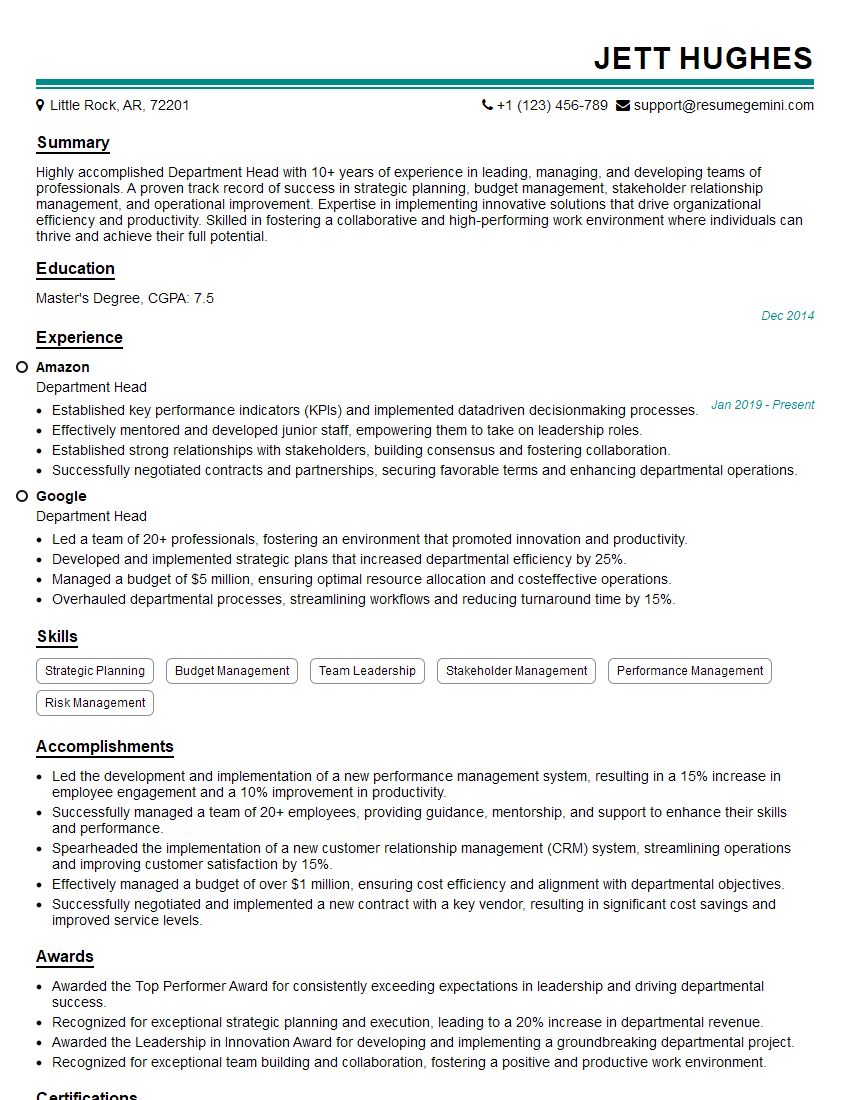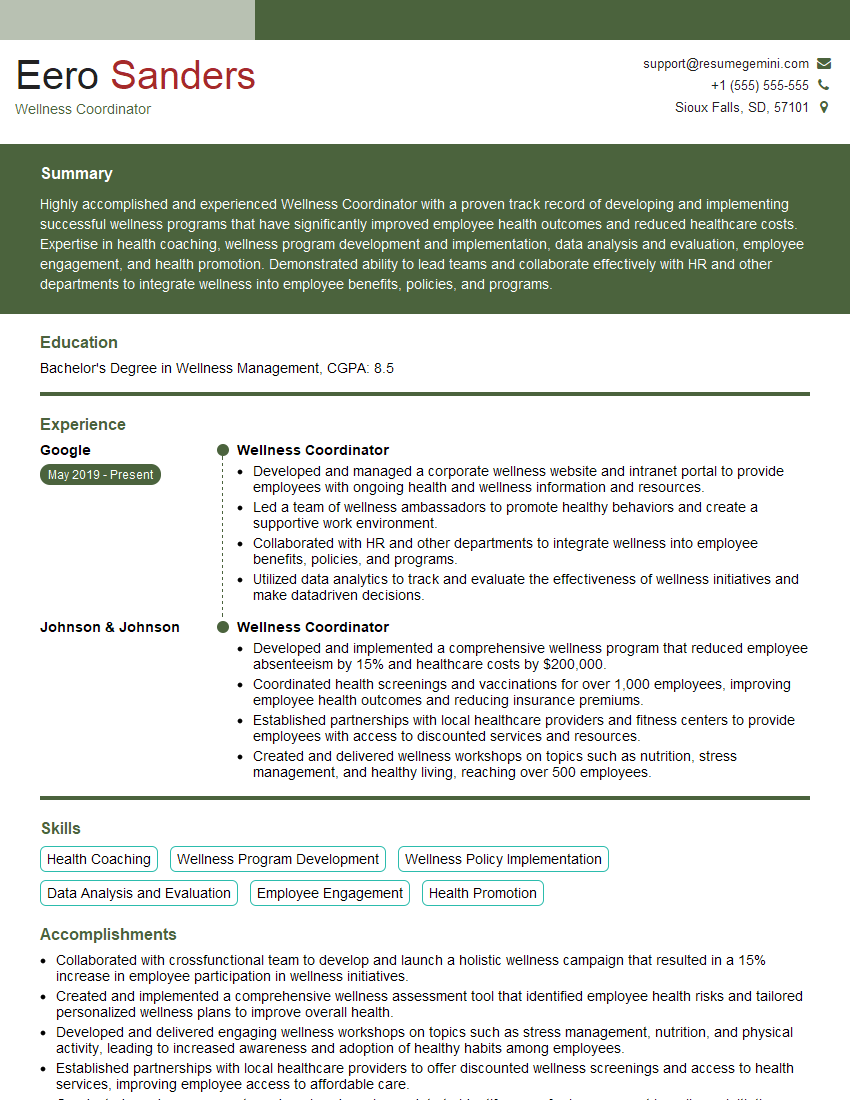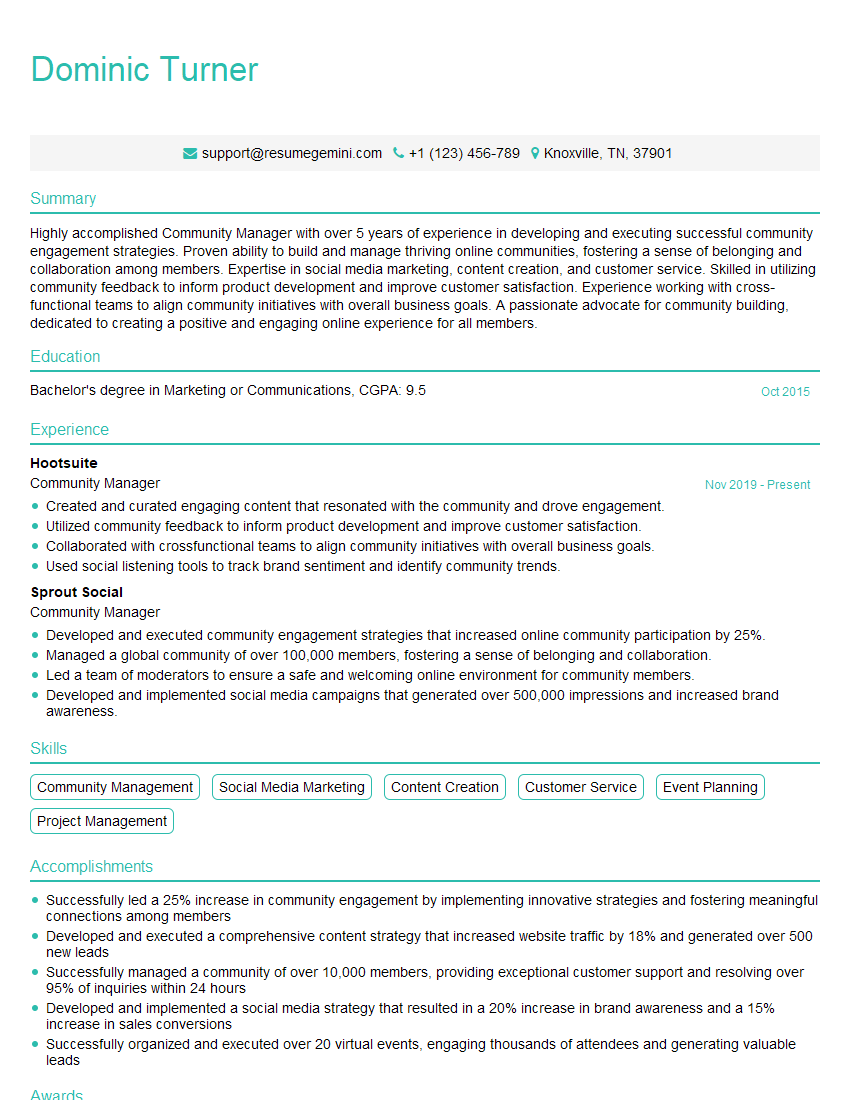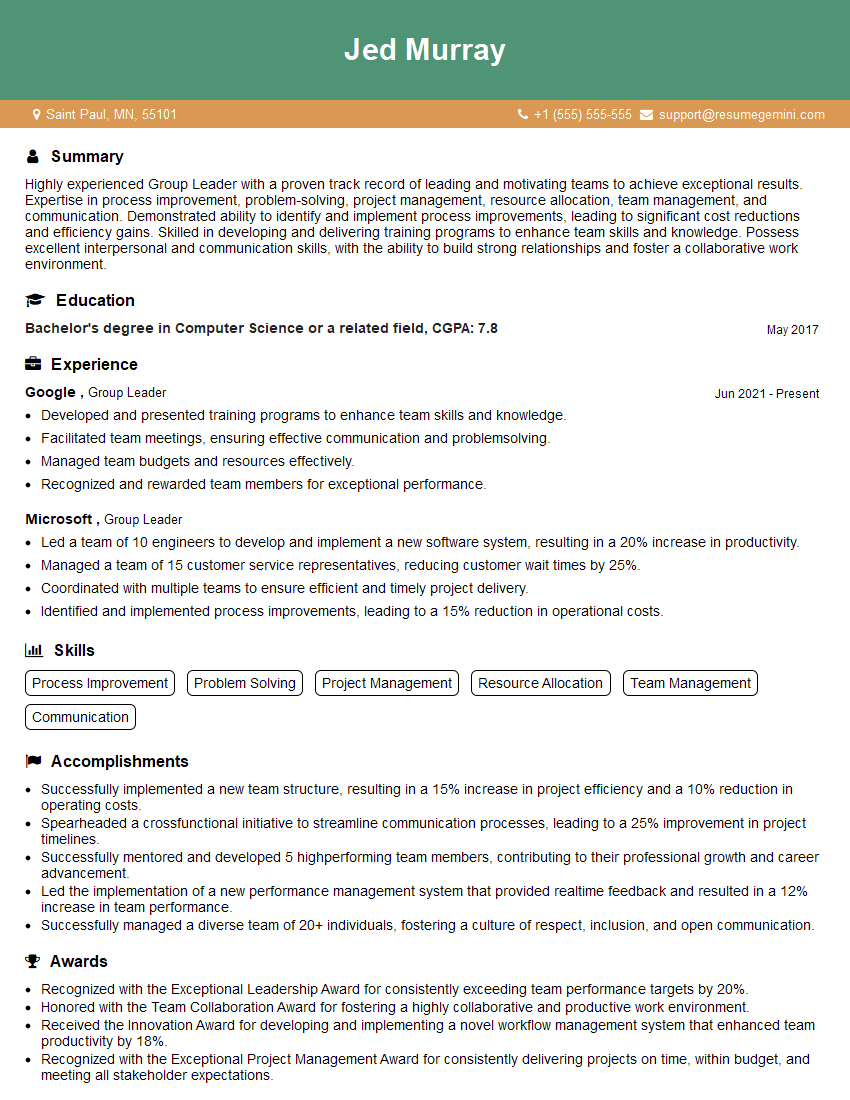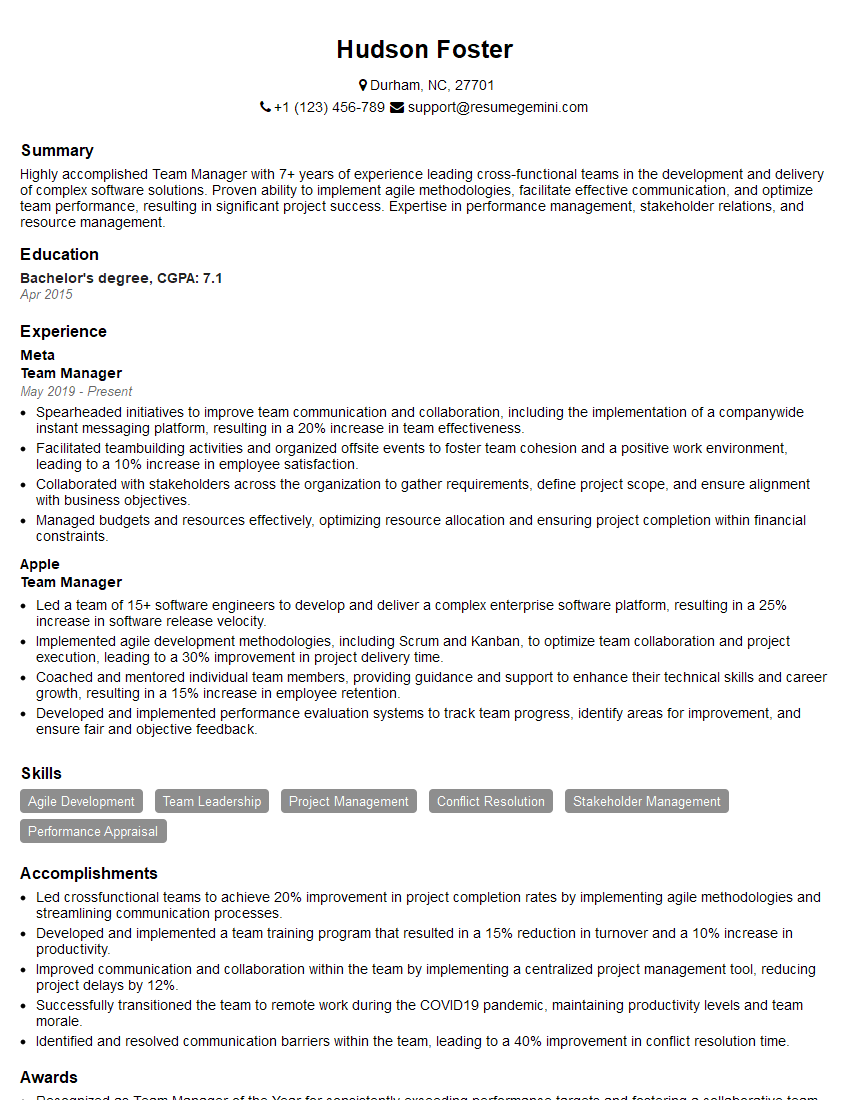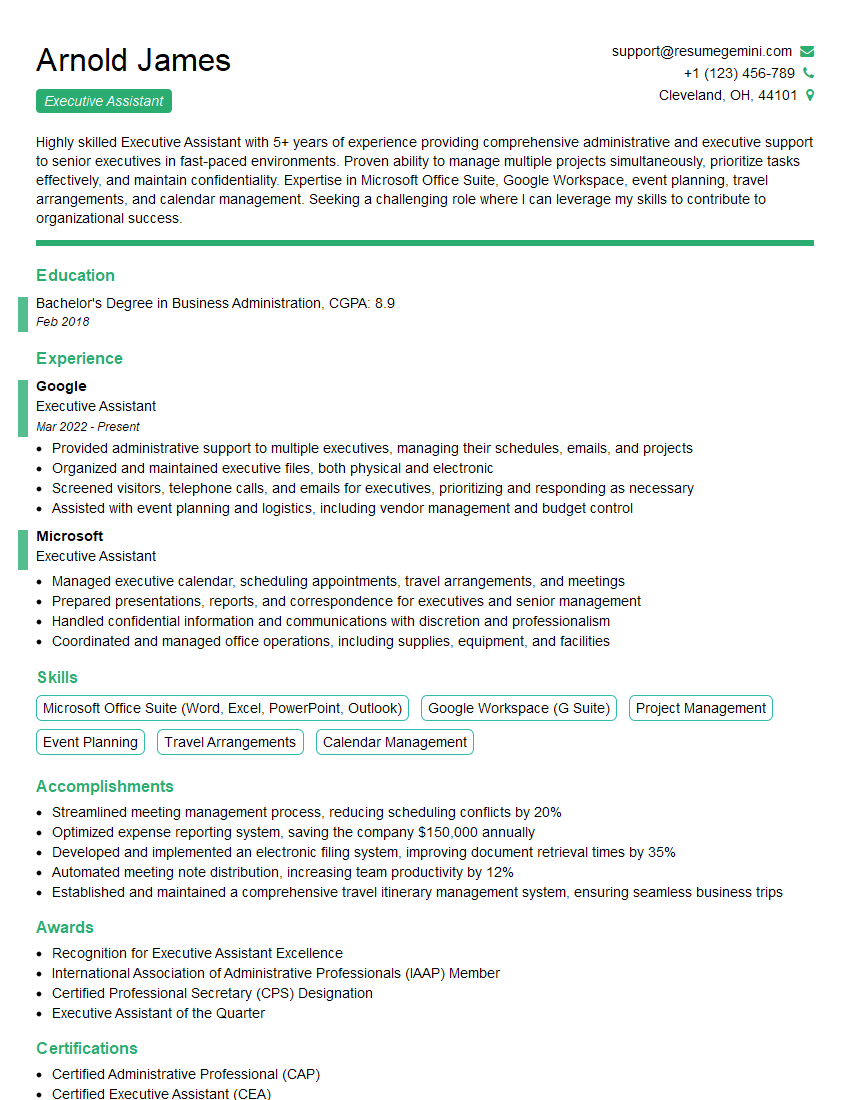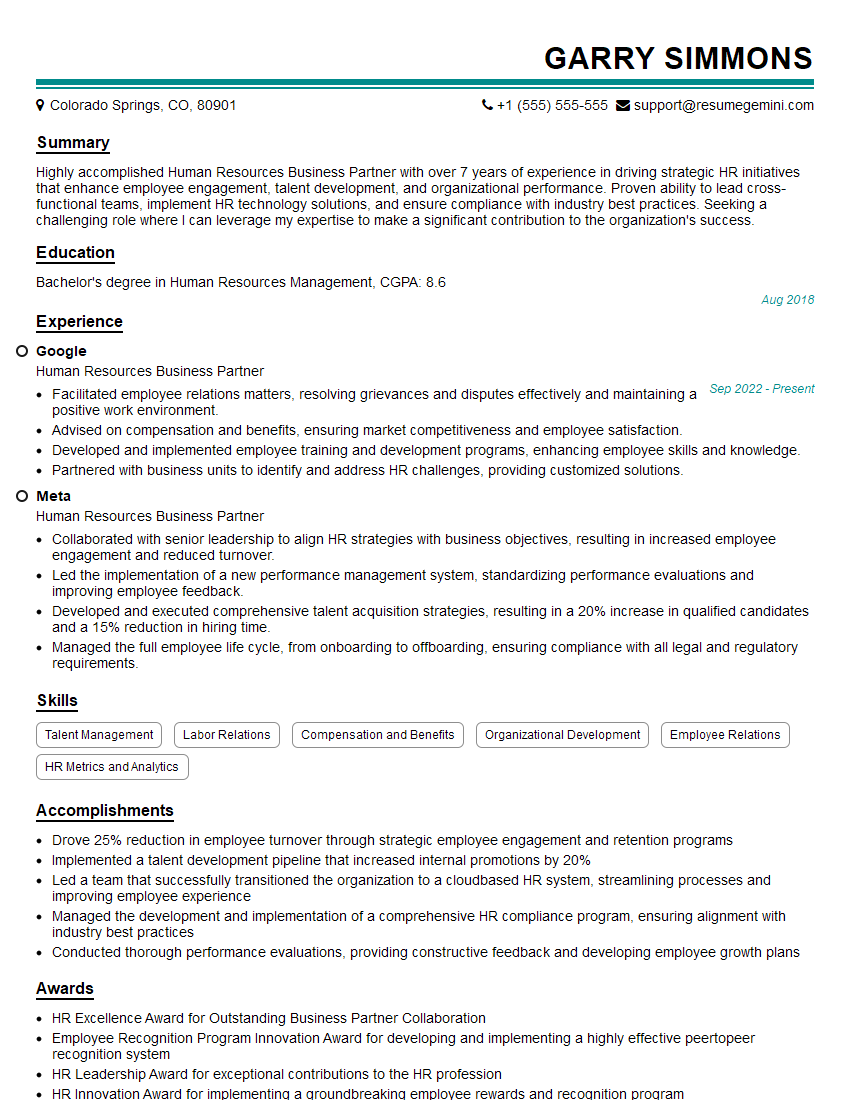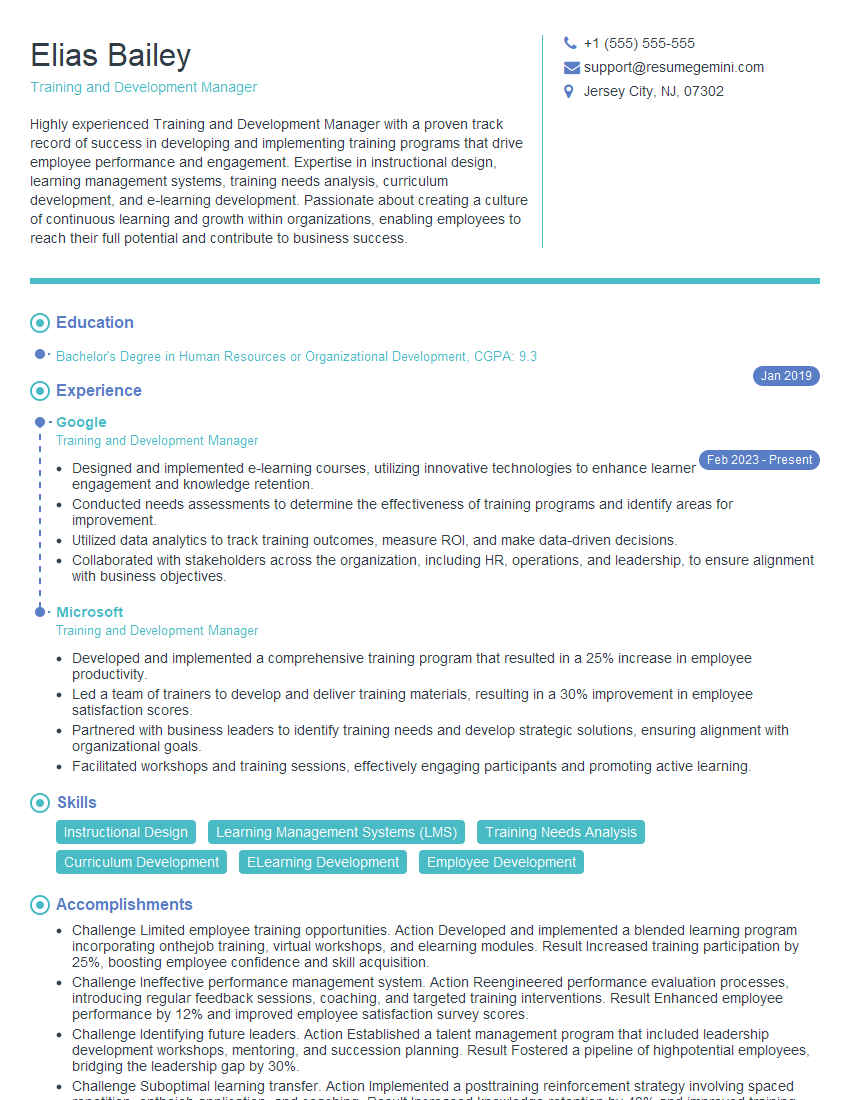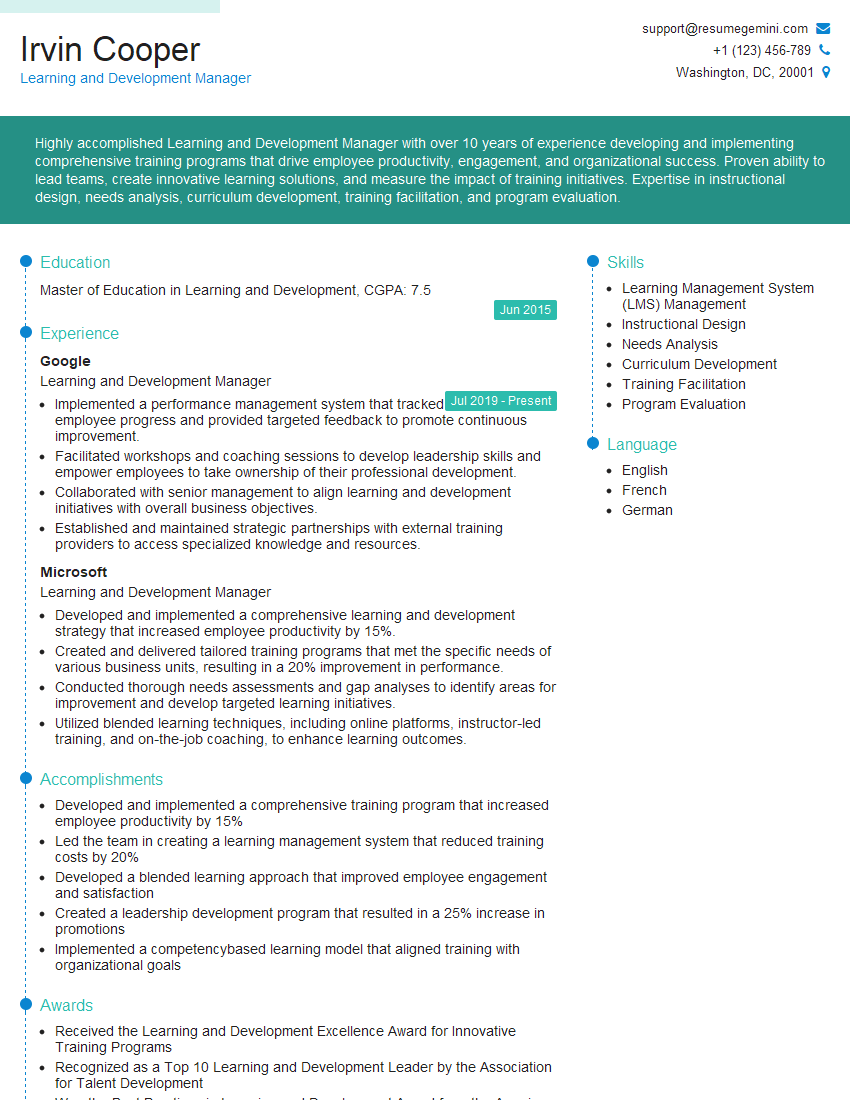Cracking a skill-specific interview, like one for Creating a Positive Team Culture, requires understanding the nuances of the role. In this blog, we present the questions you’re most likely to encounter, along with insights into how to answer them effectively. Let’s ensure you’re ready to make a strong impression.
Questions Asked in Creating a Positive Team Culture Interview
Q 1. Describe your experience fostering a collaborative team environment.
Fostering a collaborative team environment is crucial for success. It’s about building a culture where everyone feels valued, respected, and empowered to contribute their best. My approach centers around establishing clear communication channels, promoting mutual respect, and creating opportunities for shared success.
For example, in a previous role leading a software development team, I implemented daily stand-up meetings to ensure transparency on individual progress and identify potential roadblocks early. We also utilized a shared online project management tool (like Jira) to keep everyone informed about task assignments, deadlines, and progress. Beyond that, I made a conscious effort to encourage informal communication, arranging team lunches or coffee breaks to allow for relationship building and casual problem-solving.
Furthermore, I actively promoted a culture of feedback, both positive and constructive. Regular one-on-one meetings allowed team members to share their concerns, ideas, and suggestions, fostering a sense of ownership and engagement. By making these efforts, I created an environment where collaboration was not just encouraged, but actively rewarded, resulting in a more cohesive and high-performing team.
Q 2. How do you address conflict within a team to maintain a positive atmosphere?
Addressing conflict is essential for maintaining a positive atmosphere. My approach focuses on proactive conflict resolution, rather than letting issues fester. It’s about creating a safe space where team members feel comfortable expressing their concerns without fear of retribution. I typically follow a structured approach:
- Active Listening: I allow each party to fully express their perspective without interruption.
- Identifying the Root Cause: I work to understand the underlying issues fueling the conflict, going beyond surface-level disagreements.
- Finding Common Ground: I facilitate a discussion to identify shared goals and interests to help build consensus.
- Collaborative Problem-Solving: I guide the team in brainstorming solutions that address everyone’s concerns.
- Establishing Clear Agreements: We agree on actionable steps to resolve the conflict and prevent future occurrences.
For instance, I once mediated a disagreement between two team members regarding project priorities. By actively listening to both sides and focusing on their shared goal of successful project completion, we were able to identify a solution that incorporated elements of both their initial proposals.
Q 3. What strategies have you used to improve team communication and transparency?
Improving team communication and transparency is paramount. I’ve implemented several strategies, including:
- Regular Team Meetings: Scheduled meetings (both formal and informal) to share updates, discuss challenges, and brainstorm solutions.
- Open Door Policy: Fostering an environment where team members feel comfortable approaching me or each other with questions or concerns.
- Transparent Communication Tools: Utilizing project management software, shared calendars, and instant messaging to ensure timely and efficient communication.
- Feedback Mechanisms: Establishing regular feedback sessions, both formal (e.g., performance reviews) and informal (e.g., peer feedback), to encourage open communication and identify areas for improvement.
In one project, implementing a daily stand-up meeting, coupled with a shared online task management board, significantly improved transparency. It allowed everyone to track progress, anticipate potential delays, and collaborate more effectively.
Q 4. Explain how you measure the effectiveness of team-building activities.
Measuring the effectiveness of team-building activities requires a multifaceted approach. I focus on both qualitative and quantitative data.
- Qualitative Data: This includes observing team interactions during and after the activity, gathering feedback through surveys or focus groups, and analyzing the impact on team dynamics and communication. For instance, I might observe increased collaboration and open communication during subsequent project meetings.
- Quantitative Data: This could involve tracking metrics like project completion rates, employee satisfaction scores, and team productivity after the activity. For example, if a team-building exercise resulted in a measurable increase in project efficiency, it would suggest the activity was successful.
It’s important to note that the success of a team-building activity isn’t solely measured by immediate results. The long-term impact on team cohesion and communication is a key indicator of its effectiveness.
Q 5. How do you identify and address negativity or toxic behaviors within a team?
Addressing negativity or toxic behaviors requires a proactive and sensitive approach. It begins with early identification, often through observation of team dynamics, individual performance reviews, or informal feedback.
My approach involves:
- Confidential Conversations: Addressing the issue directly with the individual in a private setting, clearly outlining the behavior that is causing concern.
- Setting Clear Expectations: Establishing clear expectations for professional conduct and outlining the consequences of continued negative behavior.
- Providing Support and Resources: Offering support and resources (e.g., mentorship, conflict resolution training) to help the individual change their behavior.
- Documentation: Maintaining a record of the conversations and any subsequent actions taken.
- Escalation if Necessary: If the behavior continues despite interventions, escalating the issue to HR or management.
It’s crucial to approach this with empathy while ensuring the well-being and productivity of the entire team.
Q 6. How have you implemented initiatives to boost team morale and engagement?
Boosting team morale and engagement requires a holistic approach that acknowledges both individual and collective needs. I’ve implemented initiatives such as:
- Recognition and Rewards: Publicly acknowledging and rewarding individual and team achievements, both big and small.
- Team Social Events: Organizing team-building activities, social gatherings, and celebrations to foster camaraderie.
- Opportunities for Growth: Providing opportunities for professional development, such as training courses, mentorship programs, or challenging assignments.
- Flexible Work Arrangements: Implementing flexible work arrangements (where appropriate) to improve work-life balance.
- Open Communication: Ensuring open and transparent communication to keep the team informed and involved.
For instance, a team pizza party after a successful project launch significantly improved morale and created a sense of shared accomplishment.
Q 7. Describe a time you had to mediate a conflict between team members. What was your approach and the outcome?
In one instance, two team members, let’s call them Alex and Ben, were in conflict over the design of a key feature. Alex preferred a more minimalist approach while Ben favored a more complex design. Their disagreements were becoming increasingly contentious, impacting project progress and team morale.
My approach was to schedule a meeting with both Alex and Ben, where I employed active listening techniques to understand their perspectives. I discovered the conflict wasn’t just about aesthetics, but also stemmed from differing interpretations of user needs and technical feasibility.
Instead of dictating a solution, I facilitated a discussion where they collaboratively explored different design options. We reviewed user feedback, discussed the technical constraints, and considered the trade-offs associated with each approach. Ultimately, they compromised on a design that incorporated elements from both of their original ideas. The outcome was a more effective and well-received design, along with a strengthened working relationship between Alex and Ben. It reinforced the value of collaborative problem-solving and fostered a more constructive team dynamic.
Q 8. What are some effective strategies for onboarding new team members and integrating them into the team culture?
Onboarding new team members is crucial for fostering a positive team culture. It’s not just about paperwork; it’s about making them feel welcome, understood, and valued from day one. My approach involves a structured process focusing on both the practical and the social aspects of integration.
- Pre-boarding: Before the first day, I send a welcome package with information about the team, company culture, and their immediate responsibilities. I also schedule a brief introductory call to answer any immediate questions and build rapport.
- First Week: The first week focuses on introductions, familiarization with the workspace and tools, and a clear outline of expectations and goals. I arrange for a buddy or mentor to help navigate the initial days.
- Ongoing Integration: We incorporate the new team member into team activities, social gatherings, and project discussions gradually. Regular check-ins ensure they feel supported and heard. We utilize feedback mechanisms to ensure that the onboarding process is effective and tailored to individual needs.
- Mentorship and Training: We establish a formal mentorship program where experienced team members guide and support new hires. Comprehensive training on company policies, tools, and procedures ensures that the new team member has the resources to perform their role effectively.
For example, in my previous role, we implemented a ‘buddy system’ where experienced team members paired up with new hires. This helped build relationships and provided a comfortable avenue for seeking clarification and support. The success of this system demonstrated the positive impact of both structured onboarding and peer-to-peer support.
Q 9. How do you recognize and reward individual and team accomplishments?
Recognizing and rewarding accomplishments is essential for boosting morale and motivation. I believe in a multi-faceted approach that celebrates both individual and team contributions.
- Public Acknowledgement: Regular team meetings provide opportunities to publicly acknowledge individual and team successes. This could involve highlighting specific contributions to projects, problem-solving, or going above and beyond expectations.
- Individual Rewards: I believe in offering personalized rewards. This could be a gift card, extra time off, or a handwritten note expressing gratitude for their specific contributions. Knowing the individual preferences of team members is crucial to providing meaningful rewards.
- Team Celebrations: Team successes warrant collective celebration. This could range from a team lunch or outing to a bonus tied to project milestones. These shared moments reinforce a sense of camaraderie and achievement.
- Performance-Based Incentives: Strategic use of performance-based incentives, such as bonuses or promotions, tied to pre-defined goals, acknowledges superior performance and motivates continuous improvement.
For instance, during a particularly challenging project, my team exceeded expectations by delivering the project ahead of schedule and under budget. We celebrated this with a team dinner and publicly acknowledged each member’s contribution in a company-wide meeting. This fostered a strong sense of unity and accomplishment.
Q 10. How do you handle situations where team members are struggling with workload or stress?
Workload and stress are common challenges in any team. Addressing these issues proactively is crucial for maintaining a positive and productive work environment. My approach is based on open communication, empathy, and problem-solving.
- Open Dialogue: I encourage team members to openly discuss their workload and stress levels. Creating a safe space for vulnerability fosters trust and enables early intervention.
- Workload Assessment: I collaborate with the team member to assess their workload, identify bottlenecks, and prioritize tasks. This might involve re-allocating tasks, setting realistic deadlines, or seeking additional resources.
- Stress Management Strategies: I offer support and resources to help team members manage stress. This might involve suggesting mindfulness techniques, recommending employee assistance programs, or encouraging breaks and work-life balance.
- Time Management Training: Providing training on effective time management techniques can equip team members with the skills to better manage their workloads and reduce stress. We might also explore using project management tools to improve organization and efficiency.
In a past situation, a team member was consistently overwhelmed. Through open conversation, we identified that they lacked clarity on certain tasks and were taking on too much responsibility. By delegating tasks appropriately and clarifying expectations, we significantly reduced their stress and improved their productivity.
Q 11. Describe your process for providing constructive feedback to team members.
Constructive feedback is a vital component of fostering growth and improvement. My approach focuses on providing specific, actionable, and timely feedback delivered with empathy and respect.
- Specific Examples: Feedback should always focus on specific behaviors or actions, rather than general personality traits. For example, instead of saying “you’re disorganized,” I would say “your project timeline could benefit from clearer milestones and deadlines.”
- Focus on Behavior, Not Personality: The feedback should focus on observable actions, not the person’s inherent character. This approach is more helpful for improvement and less likely to be perceived as personal criticism.
- Balanced Feedback: It is crucial to balance positive reinforcement with constructive criticism. Start by highlighting the strengths before addressing areas for improvement. This creates a receptive environment for feedback.
- Two-Way Conversation: Feedback should be a two-way conversation, providing the team member an opportunity to respond and clarify. Active listening is critical for understanding their perspective.
- Actionable Steps: The feedback should include specific, actionable steps that the team member can take to improve. Vague feedback is unhelpful. The more concrete and practical suggestions, the better the team member can implement improvements.
For example, I recently provided feedback to a team member on a presentation. I began by acknowledging the strong points of the presentation, then offered specific suggestions on improving the visuals and flow. The conversation ensured understanding and resulted in a much-improved final presentation.
Q 12. How do you encourage open communication and feedback within your team?
Open communication and feedback are cornerstones of a thriving team. I encourage a culture of transparency and trust through various methods.
- Regular Team Meetings: Regular team meetings, whether formal or informal, create a structured environment for communication. These meetings should include time for open discussion, feedback sharing, and brainstorming.
- Feedback Mechanisms: Implementing formal and informal feedback mechanisms ensures that everyone has a voice. This could include regular anonymous surveys, feedback forms, or suggestion boxes. An open-door policy encourages informal feedback at any time.
- Transparent Communication: I prioritize clear and transparent communication in all aspects of team operations. Information is shared promptly, honestly, and inclusively. This helps to reduce misunderstandings and fosters trust.
- Active Listening: I actively listen to the concerns and opinions of my team members, showing that their input is valued. Creating a space where individuals feel safe to express their opinions without fear of judgment is vital for open communication.
- Conflict Resolution: Implementing effective conflict resolution processes can mitigate communication breakdowns and keep disagreements constructive. This might involve using mediation or collaborative problem-solving approaches.
For example, we implemented a weekly ‘feedback Friday’ where team members shared both positive feedback and constructive criticism in a non-judgmental environment. This simple process led to significant improvements in communication and team dynamics.
Q 13. What are your preferred methods for conducting performance reviews and providing developmental feedback?
Performance reviews are a critical opportunity for providing feedback, recognizing achievements, and setting goals for future growth. My approach focuses on a balanced, constructive, and collaborative process.
- Goal Setting: We begin the performance review process by reviewing goals that were established at the beginning of the review period. This provides a framework for assessing performance against clear expectations.
- Data-Driven Feedback: The review incorporates data and concrete examples to illustrate both successes and areas for improvement. This provides a factual basis for the assessment.
- Two-Way Discussion: The review is a two-way conversation. The team member’s self-assessment and perspective are incorporated into the evaluation. This ensures the review is a collaborative process, not a one-sided assessment.
- Development Plan: The review culminates in a development plan that outlines specific steps for improvement. This plan should include measurable goals and a timeline for achieving them. It should also identify resources and support to assist the team member in their development.
- Regular Check-ins: Performance is not a single snapshot in time. Throughout the year, regular check-ins allow for ongoing feedback, course correction, and identification of potential issues before they escalate.
I strive for a less formal, more conversational style. Rather than a top-down evaluation, I aim for a shared understanding of accomplishments and areas for improvement, fostering a collaborative relationship and commitment to growth.
Q 14. How do you adapt your leadership style to different team dynamics and personalities?
Adaptability is crucial for effective leadership. I adjust my leadership style to suit the specific needs and characteristics of the team and individual team members. My approach incorporates elements of various leadership styles, depending on the situation.
- Understanding Team Dynamics: I start by understanding the team’s strengths, weaknesses, and communication styles. This helps me tailor my approach to optimize team effectiveness.
- Individual Needs: Recognizing that each team member has unique needs and preferences is vital. I adjust my communication style, level of support, and feedback approach accordingly.
- Situational Leadership: I employ a situational leadership approach, adapting my style depending on the task, the team member’s experience, and the context. This might involve providing more directive guidance for new tasks or offering more autonomy for experienced team members.
- Transformational and Servant Leadership: I strive to incorporate elements of both transformational leadership (inspiring and motivating the team towards a shared vision) and servant leadership (prioritizing the needs and development of team members) in my approach.
- Open to Feedback: I am always open to feedback from my team members regarding my leadership style. This continuous learning and adaptation are vital for creating a positive and supportive environment.
For example, with a newly formed team, I adopted a more directive style, providing clear guidance and support. As the team developed, I transitioned to a more collaborative approach, empowering them to take more ownership of their work.
Q 15. How do you ensure team goals align with organizational objectives?
Aligning team goals with organizational objectives is crucial for overall success. It’s not simply about assigning tasks; it’s about ensuring everyone understands how their work contributes to the bigger picture. I achieve this through a multi-step process:
Top-Down Communication: Starting with the organization’s strategic goals, I break them down into smaller, manageable objectives. This involves actively participating in strategic planning sessions and translating high-level strategies into actionable team goals.
Collaborative Goal Setting: I facilitate workshops or meetings where team members actively participate in defining the goals. This ensures buy-in and ownership. We use techniques like OKRs (Objectives and Key Results) to ensure clarity and measurability.
Transparency and Regular Updates: I maintain open communication channels, regularly updating the team on progress toward organizational and team goals. This includes using visual dashboards and regular progress reports.
Regular Review and Adjustment: The organizational landscape is constantly changing. I ensure that we regularly review and adjust team goals as needed, aligning them with evolving organizational priorities.
For example, in my previous role, our organizational objective was to increase market share by 15%. We translated this into team-specific goals, such as improving customer satisfaction scores by 10% or launching a new product line within six months. By connecting individual contributions to the overall objective, we fostered a sense of purpose and collective responsibility.
Career Expert Tips:
- Ace those interviews! Prepare effectively by reviewing the Top 50 Most Common Interview Questions on ResumeGemini.
- Navigate your job search with confidence! Explore a wide range of Career Tips on ResumeGemini. Learn about common challenges and recommendations to overcome them.
- Craft the perfect resume! Master the Art of Resume Writing with ResumeGemini’s guide. Showcase your unique qualifications and achievements effectively.
- Don’t miss out on holiday savings! Build your dream resume with ResumeGemini’s ATS optimized templates.
Q 16. What metrics do you use to assess the overall health and effectiveness of your team?
Assessing team health and effectiveness requires a holistic approach, going beyond simply looking at output. I use a combination of qualitative and quantitative metrics:
Quantitative Metrics: These include key performance indicators (KPIs) directly related to team goals. This could be sales figures, project completion rates, customer satisfaction scores, or bug reduction rates depending on the team’s objective.
Qualitative Metrics: These provide insights into team dynamics and morale. I use regular team surveys (anonymous to encourage honest feedback), conduct one-on-one meetings to gauge individual satisfaction and challenges, and observe team interactions during meetings and collaborative sessions. I look for indicators of good communication, collaboration, and problem-solving skills.
Employee Net Promoter Score (eNPS): This metric gauges employee satisfaction and their likelihood to recommend the company as a place to work. It’s a valuable indicator of overall team health and engagement.
For instance, if we see a dip in eNPS alongside a decrease in project completion rates, it might signal a problem requiring immediate attention, like a lack of resources or a drop in team morale. By using a balanced approach, I gain a comprehensive understanding of team effectiveness.
Q 17. Explain your approach to managing remote or hybrid teams.
Managing remote or hybrid teams requires a different approach than managing co-located teams. The key is to foster a strong sense of connection and communication despite physical distance. My approach focuses on:
Structured Communication: Regular virtual meetings (using tools like Zoom or Google Meet) are crucial. I establish a clear meeting agenda and ensure everyone has an opportunity to contribute. I also use asynchronous communication tools like Slack or Microsoft Teams for quick updates and questions.
Building Relationships: While virtual, it’s important to build rapport. I encourage informal virtual coffee breaks or social events to foster connections. I make an effort to know team members personally, recognizing their individual needs and preferences.
Clear Expectations and Processes: Documenting processes and expectations clearly is crucial, especially in a remote setting. This reduces ambiguity and ensures everyone is on the same page. We use project management tools like Asana or Jira to track progress and deadlines.
Trust and Autonomy: I trust my team members to manage their work independently. Micromanaging is detrimental in remote settings. I focus on results and provide support when needed.
I also actively seek feedback from the team on the effectiveness of our communication and working processes. Regular check-ins help identify areas for improvement and ensure everyone feels supported and connected.
Q 18. How do you foster a sense of belonging and inclusion within your team?
Fostering a sense of belonging and inclusion requires creating a psychologically safe environment where everyone feels valued, respected, and heard. My strategies include:
Open Communication: Creating a culture of open and honest communication where individuals feel comfortable sharing their ideas and concerns without fear of judgment.
Active Listening and Empathy: Demonstrating genuine interest in team members’ perspectives and experiences. I make sure everyone feels their voice is heard and valued.
Celebrating Diversity: Recognizing and appreciating the unique backgrounds, perspectives, and experiences of each team member. This could involve sharing personal stories or celebrating cultural events.
Inclusive Team Activities: Organizing team-building activities that cater to diverse interests and abilities. This could include virtual game nights, team lunches (catering to dietary needs), or volunteering opportunities.
Zero Tolerance for Discrimination: Establishing clear policies and procedures against any form of harassment or discrimination. Creating a safe space where reporting such incidents is easy and without fear of retribution.
For instance, I’ve organized team-building activities around shared interests, such as a book club or a virtual cooking class, to help team members connect on a more personal level, fostering a stronger sense of community.
Q 19. Describe your experience in implementing diversity and inclusion initiatives within a team.
Implementing diversity and inclusion initiatives requires a proactive and multifaceted approach. My experience involves:
Diverse Hiring Practices: Actively recruiting from diverse talent pools and ensuring interview panels are diverse to mitigate unconscious bias.
Inclusive Onboarding: Designing onboarding programs that welcome and integrate new team members from diverse backgrounds.
Mentorship Programs: Establishing mentorship programs to support and guide individuals from underrepresented groups.
Diversity Training: Providing regular diversity and inclusion training for all team members to raise awareness and build understanding.
Regular Feedback Mechanisms: Regularly gathering feedback on team diversity and inclusion efforts to identify areas needing improvement. Using anonymous surveys is crucial for honesty.
In a previous project, we implemented a blind resume screening process during recruitment. Removing identifying information allowed us to focus solely on skills and experience, resulting in a more diverse and talented team.
Q 20. How do you deal with situations where team members exhibit resistance to change?
Resistance to change is a common challenge. My approach focuses on understanding the root cause of the resistance and addressing it effectively:
Open Communication and Understanding: Actively listening to concerns and addressing them openly. I encourage team members to share their perspectives without judgment.
Transparency and Involvement: Explaining the reasons behind the change and involving team members in the decision-making process whenever possible. This fosters a sense of ownership and reduces resistance.
Empathy and Support: Recognizing that change can be difficult and offering support and resources to help team members adapt. This may involve providing training, mentorship, or additional time for adjustment.
Incremental Change: Implementing changes gradually to minimize disruption and provide time for adjustment. Small, manageable steps are often easier to accept than drastic overhauls.
Celebrate Successes: Highlighting successes along the way to build momentum and demonstrate the positive impacts of change.
In one instance, a team resisted a new software system. By actively listening to their concerns (which centered on the steep learning curve), I arranged for extra training sessions and offered one-on-one support. This reduced resistance and eventually led to widespread adoption.
Q 21. What strategies do you use to promote work-life balance among team members?
Promoting work-life balance is essential for a healthy and productive team. My strategies include:
Flexible Work Arrangements: Offering flexible working hours, remote work options, or compressed workweeks whenever possible.
Clear Expectations and Boundaries: Setting clear expectations for work hours and encouraging team members to disconnect after work hours. This includes discouraging emails or calls outside of designated working hours unless absolutely necessary.
Encourage Time Off: Encouraging team members to take their vacation time and reminding them of the importance of rest and rejuvenation. Leading by example is important here.
Wellness Initiatives: Offering resources to support employee wellness, such as mental health resources, gym memberships, or wellness programs.
Open Dialogue: Creating a culture where team members feel comfortable discussing work-life balance concerns without fear of judgment.
I regularly remind my team members that their well-being is a priority and that they shouldn’t feel guilty for taking breaks or using their vacation time. A well-rested and happy team is a productive team.
Q 22. How do you create a culture of continuous learning and development within your team?
Cultivating a culture of continuous learning is paramount for team growth and innovation. It’s not just about attending workshops; it’s about embedding learning into the daily fabric of the team. I approach this in a multifaceted way.
Mentorship and Buddies: Pairing experienced team members with newer ones fosters knowledge transfer and creates a supportive environment for growth. I’ve found that informal mentorship programs, where individuals can choose mentors based on their interests, are particularly effective.
Dedicated Learning Time: Allocating specific time each week or month for team members to pursue professional development activities, whether it’s online courses, reading industry publications, or attending webinars, shows a commitment to learning. This time shouldn’t be seen as ‘extra’ but as integral to their roles.
Knowledge Sharing Sessions: Regular sessions where team members share their learnings, insights, or even challenges encountered contribute to a collective learning experience. This can be done through informal presentations, brown bag lunches, or even a dedicated online forum.
Feedback and Reflection: Implementing a structured feedback system, incorporating regular performance reviews and 360-degree feedback, helps individuals identify areas for improvement and track their progress. Encouraging self-reflection through journaling or regular check-ins also significantly contributes.
External Training and Conferences: Providing opportunities to attend industry conferences or external training programs keeps the team abreast of the latest trends and best practices. I always try to secure funding for at least one team member per year to attend relevant industry events.
Q 23. How do you use technology to enhance team collaboration and communication?
Technology plays a crucial role in fostering seamless collaboration and communication within a team. Simply having the tools isn’t enough; it’s about choosing the right tools and utilizing them effectively.
Project Management Software (e.g., Asana, Trello, Jira): These platforms allow for centralized task management, progress tracking, and improved transparency. They help avoid email overload and ensure everyone is on the same page regarding deadlines and responsibilities. For example, using Kanban boards in Trello visually represents workflow and helps in identifying bottlenecks.
Communication Platforms (e.g., Slack, Microsoft Teams): These tools facilitate instant communication, file sharing, and quick brainstorming sessions. Creating dedicated channels for different projects or teams ensures focused communication and reduces noise. Using threaded conversations helps keep discussions organized and easy to follow.
Video Conferencing (e.g., Zoom, Google Meet): Regular video meetings help maintain a strong sense of connection, especially in remote or hybrid teams. They allow for richer communication and help foster stronger relationships amongst team members.
Document Collaboration Tools (e.g., Google Docs, Microsoft 365): These enable real-time co-editing of documents, eliminating version control issues and promoting efficient teamwork. The ability to leave comments and track changes directly within the document streamlines the review and approval process.
Beyond the tools themselves, it’s essential to establish clear communication protocols and guidelines. For instance, defining response times for different communication channels ensures prompt and efficient communication.
Q 24. Describe a time you had to address a significant team challenge or setback. How did you approach it and what was the result?
In a previous role, our team faced a significant setback when a major client project went significantly over budget due to unforeseen technical challenges. Instead of assigning blame, I focused on collaborative problem-solving.
Transparency and Open Communication: I held an open team meeting to discuss the issue honestly and transparently. This allowed everyone to express their concerns and ideas openly, without fear of retribution.
Root Cause Analysis: We conducted a thorough root cause analysis, involving all team members, to identify the factors that contributed to the budget overrun. This involved brainstorming sessions and data analysis to pinpoint the exact issues.
Actionable Solutions: Based on the root cause analysis, we developed a comprehensive action plan with clearly defined roles and responsibilities. This included strategies for better risk management, improved communication with the client, and a revised project timeline.
Client Communication: I personally communicated the situation and the action plan to the client, emphasizing our commitment to resolving the issues and minimizing the impact. Open and honest communication with the client was crucial in maintaining trust.
The result was that we successfully salvaged the project, although it took additional effort and time. More importantly, the team emerged stronger, having learned valuable lessons about risk management, proactive communication, and collaborative problem-solving. This experience also solidified trust and respect amongst the team members.
Q 25. What are your thoughts on the importance of celebrating both big and small wins within a team?
Celebrating both big and small wins is absolutely crucial for building a positive team culture. It’s a powerful way to boost morale, recognize individual contributions, and reinforce positive behavior.
Big Wins: These require larger celebrations – perhaps a team lunch, a company-wide announcement, or a bonus system. The key is to make the celebration memorable and proportionate to the accomplishment. It should reflect the hard work and dedication involved.
Small Wins: Acknowledging small victories, such as completing a challenging task, meeting a milestone, or exceeding a personal goal, is just as important. Simple things like a verbal “well done,” a quick email of appreciation, or a team shout-out can make a significant difference. Consistency is key here.
Celebrating success fosters a sense of shared accomplishment, increases team cohesion, and creates a positive feedback loop, encouraging further success. It’s an investment in team morale that yields significant returns.
Q 26. How would you approach building a positive team culture in a newly formed team?
Building a positive culture in a newly formed team requires proactive effort and a focus on relationship-building from day one.
Team Building Activities: Early team-building exercises help break the ice and foster camaraderie. These can range from simple icebreaker games to more involved activities, tailored to the team’s preferences.
Clearly Defined Goals and Values: Establishing clear team goals and values provides direction and a shared sense of purpose. Involving the team in defining these values creates ownership and buy-in.
Open Communication Channels: Setting up effective communication channels from the outset prevents misunderstandings and encourages collaboration. This includes establishing regular team meetings and making sure everyone feels comfortable expressing their opinions.
Regular Feedback and Recognition: Providing regular feedback and recognizing individual contributions reinforces positive behavior and encourages team members to strive for excellence.
Leadership by Example: As a leader, it’s crucial to model the desired behavior. This includes being supportive, encouraging, and demonstrating a commitment to the team’s success.
The foundation of a positive team culture is trust and respect. Creating a safe and inclusive environment where team members feel valued and respected is paramount for long-term success.
Q 27. How do you ensure that your team’s values align with the overall company culture?
Ensuring alignment between team values and overall company culture is crucial for maintaining consistency and minimizing conflict. This requires a two-pronged approach.
Understanding Company Culture: A thorough understanding of the company’s mission, vision, and values is essential. This involves reviewing company documentation, attending relevant meetings, and engaging with other departments to gain a holistic perspective.
Integrating Company Values into Team Practices: Once the company culture is understood, I integrate these values into the team’s daily operations. This might involve incorporating company values into team goals, performance reviews, and decision-making processes. For example, if the company prioritizes innovation, the team might be encouraged to dedicate time for brainstorming and experimentation.
Open Dialogue and Feedback: Regular discussions with team members regarding the alignment between team and company values are crucial. This creates a platform for addressing potential conflicts and ensuring everyone is on board.
By actively fostering this alignment, I create a synergistic environment where individual team efforts contribute effectively to the overarching company goals. This fosters a sense of shared purpose and strengthens the team’s connection to the wider organization.
Key Topics to Learn for Creating a Positive Team Culture Interview
- Understanding Team Dynamics: Learn to identify different personality types and communication styles within a team, and how to leverage these for collaborative success. Consider the impact of groupthink and how to mitigate it.
- Building Trust and Psychological Safety: Explore practical strategies for fostering open communication, active listening, and a culture where team members feel comfortable taking risks and sharing ideas without fear of judgment. Think about how to address conflict constructively.
- Effective Communication and Feedback: Master techniques for providing both positive and constructive feedback, ensuring it’s timely, specific, and actionable. Explore different communication channels and their appropriateness in different situations.
- Conflict Resolution and Mediation: Learn about various conflict resolution styles and how to choose the most appropriate approach depending on the situation and individuals involved. Develop skills in mediating disagreements and facilitating productive conversations.
- Promoting Collaboration and Teamwork: Understand how to design collaborative work processes, facilitate team meetings effectively, and create a shared sense of purpose and vision. Explore different team-building activities and their effectiveness.
- Recognizing and Rewarding Contributions: Learn strategies for recognizing individual and team achievements, fostering a culture of appreciation and motivation. Consider different reward systems and their impact on team morale.
- Leading by Example: Discuss the importance of personal accountability, ethical conduct, and demonstrating the positive behaviors you expect from your team members. Reflect on your own leadership style and its impact on team culture.
Next Steps
Mastering the art of creating a positive team culture is crucial for career advancement. It demonstrates valuable leadership skills and your ability to build high-performing teams. To showcase these skills effectively, create an ATS-friendly resume that highlights your relevant experience and accomplishments. Use ResumeGemini to build a professional and impactful resume that will get noticed by recruiters. ResumeGemini offers examples of resumes tailored to showcasing expertise in creating a positive team culture, helping you present your skills in the best possible light.
Explore more articles
Users Rating of Our Blogs
Share Your Experience
We value your feedback! Please rate our content and share your thoughts (optional).
What Readers Say About Our Blog
Hello,
We found issues with your domain’s email setup that may be sending your messages to spam or blocking them completely. InboxShield Mini shows you how to fix it in minutes — no tech skills required.
Scan your domain now for details: https://inboxshield-mini.com/
— Adam @ InboxShield Mini
Reply STOP to unsubscribe
Hi, are you owner of interviewgemini.com? What if I told you I could help you find extra time in your schedule, reconnect with leads you didn’t even realize you missed, and bring in more “I want to work with you” conversations, without increasing your ad spend or hiring a full-time employee?
All with a flexible, budget-friendly service that could easily pay for itself. Sounds good?
Would it be nice to jump on a quick 10-minute call so I can show you exactly how we make this work?
Best,
Hapei
Marketing Director
Hey, I know you’re the owner of interviewgemini.com. I’ll be quick.
Fundraising for your business is tough and time-consuming. We make it easier by guaranteeing two private investor meetings each month, for six months. No demos, no pitch events – just direct introductions to active investors matched to your startup.
If youR17;re raising, this could help you build real momentum. Want me to send more info?
Hi, I represent an SEO company that specialises in getting you AI citations and higher rankings on Google. I’d like to offer you a 100% free SEO audit for your website. Would you be interested?
Hi, I represent an SEO company that specialises in getting you AI citations and higher rankings on Google. I’d like to offer you a 100% free SEO audit for your website. Would you be interested?
good

